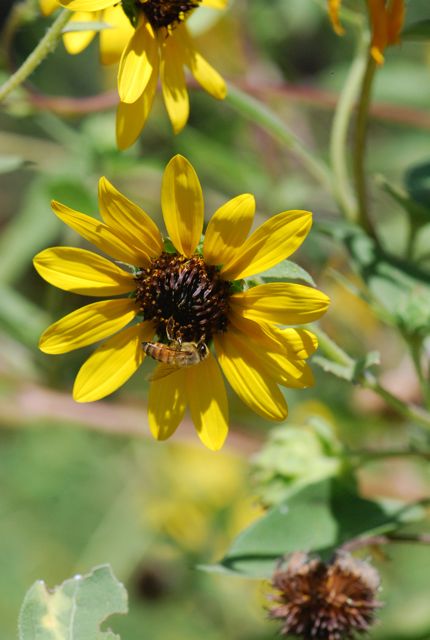
These seeds come with a puff of fluff.


Any ideas what they might be?
Edit: The answer is now posted.

These seeds come with a puff of fluff.


Any ideas what they might be?
Edit: The answer is now posted.
Did you identify the mystery seeds last week as sunflower seeds?

In fact they were the black oil sunflower seeds sold as bird food. Those grow pretty easily.

Did you know sunflowers were originally from the New World? There are about 80 different species, including the so-called Jerusalem artichoke, Helianthus tuberosus. The wild kinds often have many small flowers, and many are perennials.

The lesser goldfinches were having a field day in these sunflowers.
There are a lot of different varieties of annual sunflowers (Helianthus annuus).

This is a Lemon Queen, grown for the Great Sunflower Project last year.
Many animals benefit from the flowers and seeds.

Many bees and other insects enjoy the pollen and nectar from the flowers.

Of course, people enjoy eating sunflower seeds, too. Have you ever had sunflower seed butter? It is a nice change of pace from peanut butter.

Sunflowers are cool because the buds of some varieties follow the sun throughout the day. As the flowers start to produce seed, however, I’ve noticed that they tend to stop moving. Often they begin to drop downwards.
Here in Arizona sunflowers will grow throughout the year and they are pretty drought tolerant, too.
Have you grown sunflowers? What varieties are your favorites?
If not, you should give them a try.
I’m “sprucing” things up here at Growing with Science in preparation for hosting the Festival of the Trees Carnival (edit: now defunct) at the end of the month. For the next few weekend science fun posts, we’ll be learning about trees and doing some fun tree science activities.
Most of us recognize a big tree when we see one, but sometimes it may be hard to tell whether a plant is a large shrub or a small tree. What do you think? Brainstorm and write down all the words you use to describe a tree.
One definition might be “a tree is a perennial, woody plant that grows to at least 20 feet tall and has an erect (straight up) main stem.” Talk about what that means and if all the trees you know will fit this definition. Can you think of something more? Let us know what you decide.

Trees are so important. Can you think of a list of benefits of trees? Here’s just a few we thought of:
Can you add to this list? Do some research to find more benefits of trees, for example an extensive list and more links at Canopy.org.
Find an appropriately sized tree where children can label the following parts.
Vocabulary:
Make index cards with each of these names (make sure you have at least one card for each child participating.) Punch holes in the cards with a hole punch. Cut pieces of yarn of various lengths. H
Have the children attach the cards to the correct parts of a tree with pieces of yarn – a fun way to decorate a tree. Take extra cards and draw any parts that are missing, such as flowers, nuts or fruit. Add those to the tree where they might be found. Older children can discuss the function of each of the parts, such as roots hold up the tree (support) and bring water into the tree.
Note: Scissors speed up card removal when you are finished.

Sketching trees is a good way to learn the shape of different kinds. Sketch a tree from a photograph and label the parts if you can’t go outside.
See if you can find a “tree cookie,” a cross-sectional piece of wood through a tree trunk. Tree cookies are often available at craft stores. Those with the bark still on are the best.
Internal parts of a tree:
Look at the tree cookie and see how new rings are added each year. Explain how the tree only grows from the cambium and cutting it (for example by carving initials on a living tree), damages its ability to grow and live. A fun demonstration of how a tree grows might be to add layers of clothes to a doll or person, to show how the tree expands by adding layers. See if you can tell how old the tree that made the tree cookie was when it was cut down by counting the rings.
 Public domain image by Brer Lappin at Wikimedia.
Public domain image by Brer Lappin at Wikimedia.
Additional Resources:
Hope you enjoy our celebration of tees this month. If you have any suggestions for activities or websites, please let us know.

© 2025 Growing With Science Blog
Theme by Anders Noren — Up ↑